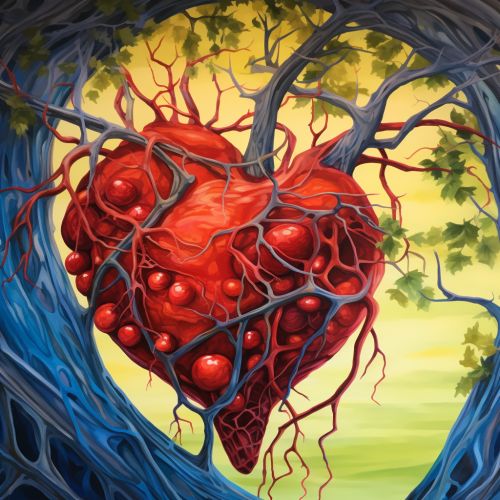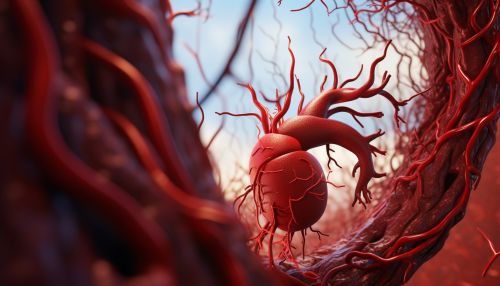Occlusion
Definition
Occlusion in the context of medical and biological sciences refers to the blockage or closing of a blood vessel or hollow organ. It is a process that can occur naturally or artificially in various parts of the body, including the arteries, veins, and digestive system.
Types of Occlusion
There are several types of occlusion that can occur in the human body, each with its own causes, symptoms, and treatments.
Arterial Occlusion


Arterial occlusion is a condition where the arteries, which carry oxygen-rich blood from the heart to the rest of the body, become blocked. This can occur due to a buildup of fatty deposits on the inner walls of the arteries, a condition known as atherosclerosis.
Venous Occlusion
Venous occlusion refers to the blockage of a vein, which carries deoxygenated blood from the body back to the heart. This is often caused by a blood clot, known as a thrombus.
Digestive Occlusion
Digestive occlusion, also known as bowel obstruction, occurs when the flow of fluids or solids is blocked in the digestive tract. This can be due to a variety of causes, including tumors, adhesions, or hernias.
Causes
The causes of occlusion vary depending on the type and location in the body.
Causes of Arterial Occlusion
The primary cause of arterial occlusion is atherosclerosis, which is the buildup of fatty deposits on the inner walls of the arteries. Other causes can include injury to the artery, infection, or certain medications.
Causes of Venous Occlusion
Venous occlusion is most commonly caused by a blood clot, or thrombus. Other causes can include varicose veins, injury to the vein, or certain medical conditions such as cancer or inflammatory diseases.
Causes of Digestive Occlusion
Digestive occlusion can be caused by a variety of factors, including tumors, adhesions (bands of scar tissue that form after surgery), hernias, or certain diseases such as Crohn's disease or diverticulitis.
Symptoms
The symptoms of occlusion can vary greatly depending on the type and location of the occlusion.
Symptoms of Arterial Occlusion
Symptoms of arterial occlusion can include pain, numbness, or weakness in the muscles supplied by the affected artery. In severe cases, it can lead to tissue death, or necrosis.
Symptoms of Venous Occlusion
Symptoms of venous occlusion can include swelling, pain, and skin discoloration in the area supplied by the affected vein. In severe cases, it can lead to complications such as deep vein thrombosis or pulmonary embolism.
Symptoms of Digestive Occlusion
Symptoms of digestive occlusion can include abdominal pain, bloating, constipation, and vomiting. In severe cases, it can lead to complications such as bowel perforation or sepsis.
Diagnosis
Diagnosis of occlusion typically involves a combination of physical examination, medical history, and imaging tests.
Diagnosis of Arterial Occlusion
Arterial occlusion is often diagnosed using imaging tests such as ultrasound, computed tomography (CT) scan, or magnetic resonance imaging (MRI). In some cases, a procedure known as angiography may be used to visualize the arteries.
Diagnosis of Venous Occlusion
Venous occlusion is typically diagnosed using ultrasound, which can visualize the veins and detect any blockages. In some cases, venography may be used to provide a more detailed view of the veins.
Diagnosis of Digestive Occlusion
Digestive occlusion is typically diagnosed using imaging tests such as X-ray, CT scan, or MRI. In some cases, a procedure known as endoscopy may be used to visualize the digestive tract.
Treatment
Treatment of occlusion depends on the type and severity of the occlusion, as well as the overall health of the patient.
Treatment of Arterial Occlusion
Treatment of arterial occlusion may involve lifestyle changes, medications, or in severe cases, surgery. The goal of treatment is to restore blood flow to the affected area and prevent complications.
Treatment of Venous Occlusion
Treatment of venous occlusion typically involves medications to dissolve the clot and prevent new clots from forming. In some cases, procedures such as thrombolysis or thrombectomy may be used to remove the clot.
Treatment of Digestive Occlusion
Treatment of digestive occlusion typically involves relieving the obstruction, either through medications, endoscopic procedures, or surgery.
